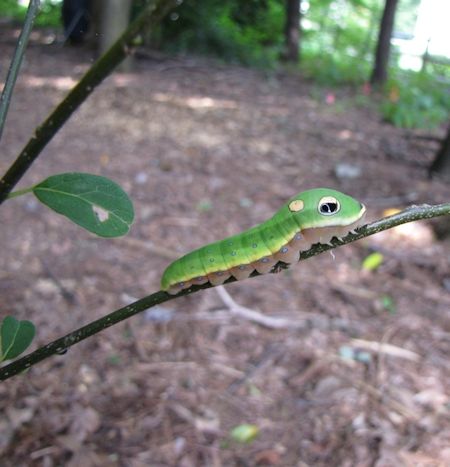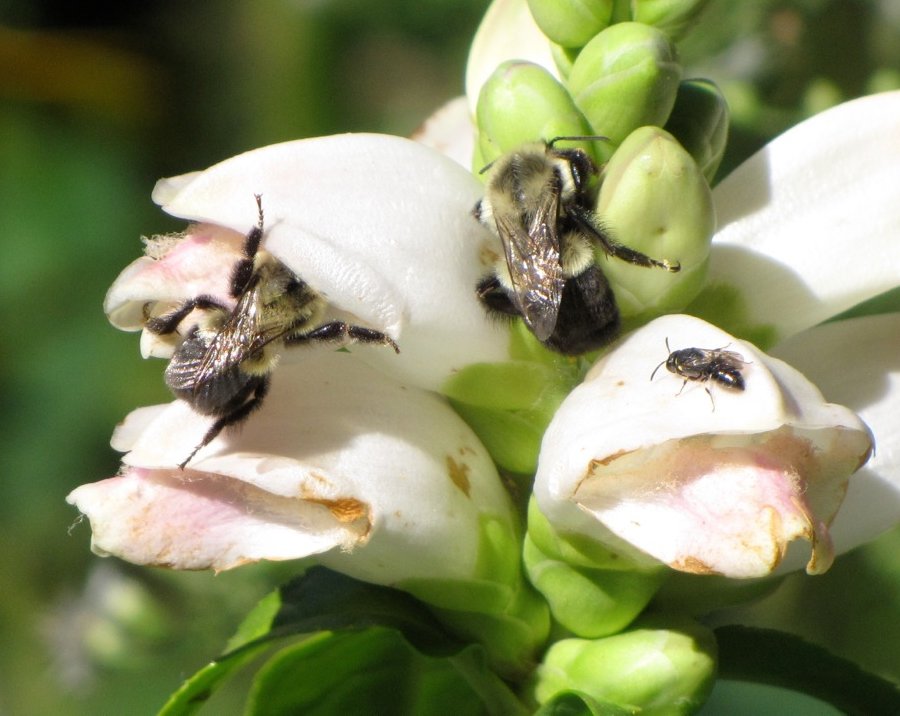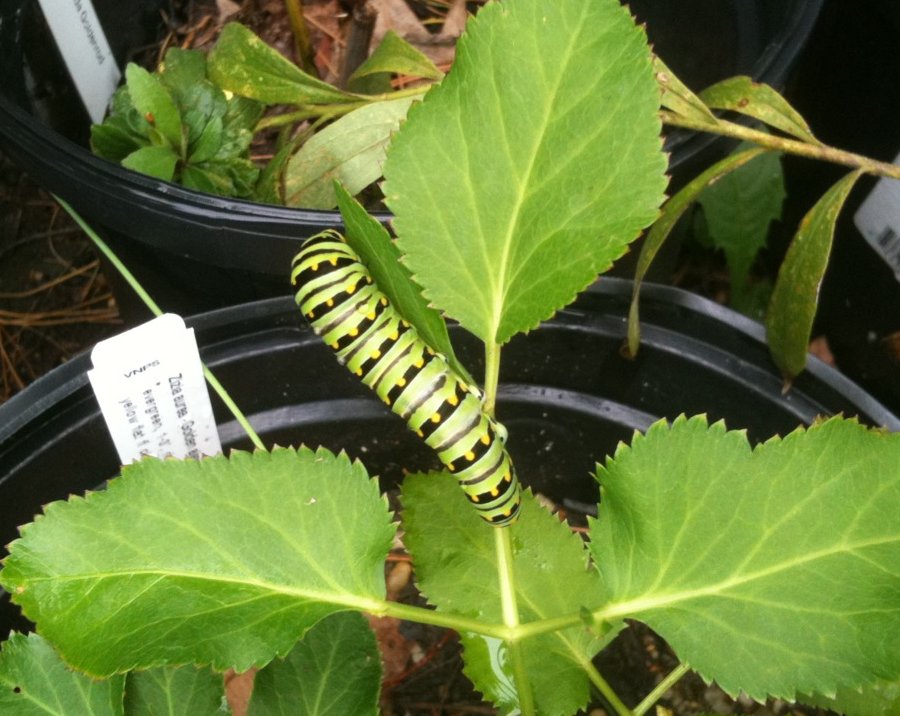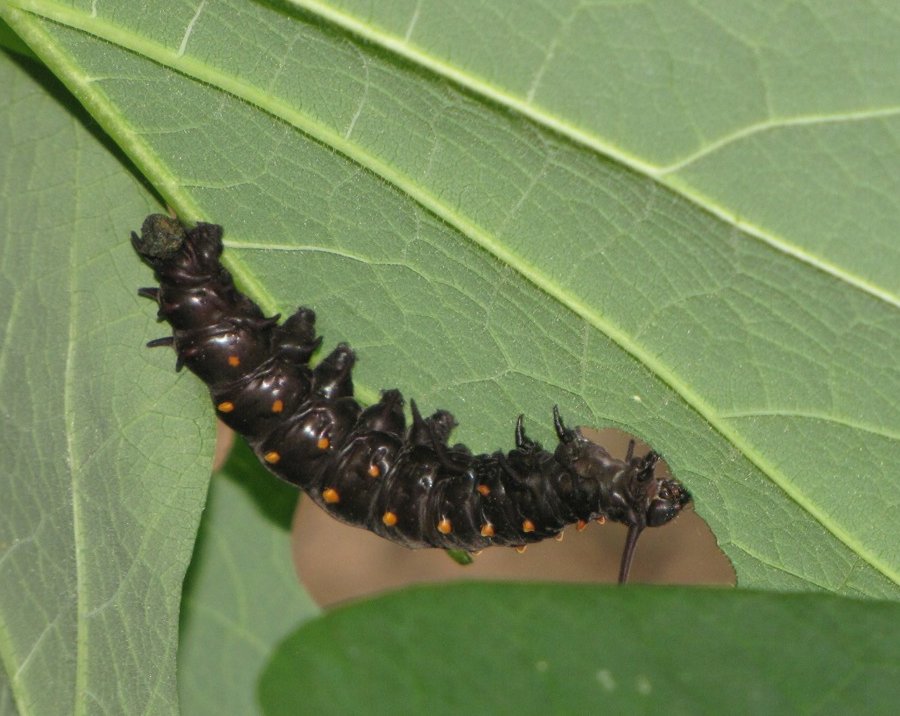The Interdependence of Natural Resources

At the quarterly meeting of FODMers and friends on May 11, 2016, Alan Ford and Laura Beaty gave a presentation on the interrelationships of plants and animals and the important role of pollinators and leaf-eaters. Alan is president of the Potowmack Chapter of the Virginia Native Plant Society and Laura chairs the Propagation Committee.
Citing the work of University of Delaware's Entomology Chair, Douglas Tallamy, they explained that native plants and animals that co-evolved are often dependent on each other, integral parts of functioning ecosystems, and that by favoring native plants over non-natives, people can increase, restore and protect nature’s biodiversity. They emphasized that insects like butterflies need plants that provide nectar for adults and plants that host larvae. Among the pollinators they covered were ground bees, flies, bumblebees, cutter bees, butterflies, moths and hummingbirds. In the photo, a spicebush swallowtail caterpillar is on a spicebush, Lindera benzoin (photo courtesy of Donna Murphy).
Here are several examples that Laura discussed:
- Caterpillars are leafeaters. The caterpillar of the tiger swallowtail butterfly (Papilio glaucous) eats the leaves of the tulip tree (Liriodendron tulipifera) and in the fall Northern cardinals (Cardinalis cardinalis) eat the tulip trees’ seeds. Leafcutter bees (Megachile spp.) chew holes in the leaves of redbud trees (Cercis canadensis).
- Black cherry trees (Prunnus serotina) are host plants for tent caterpillars (Malacosoma americanum), food for many birds that need protein, especially spring migrating birds and birds raising and feeding their young.
- Oaks (Quercus) support 534 species of Lepidoptera.
- The caterpillar of the monarch butterfly (Danaus plexippus) feeds on members of the milkweed family (Asclepiadaceae).
- Many plants in Northern Virginia have fall berries which are food for migrating birds, plants like greenbrier (Smilax spp.), poison ivy, (Toxicodendron radicans) and Virginia creeper (Parthenocissus quinquefolia).
- Hummingbirds feed on tubular flowers, like coral honeysuckle (Lonicera sempervirens) and columbine (Aquilegia canadensis).
- Bumblebees are like “flying dust mops” because they collect and disperse pollen from plants like Joe Pye weed (Eupatoriadelphus fistulosum).
 White turtlehead, Chelone glabra, with prime pollinator, bumblebeeDead tree snags have several important ecological roles, Laura stressed. Beetles make small holes which hairy (Picoides villosus) and downy woodpeckers (Picoides pubescent) enlarge and use. Then, red-bellied woodpeckers (Melanerpes carolinus) and pileated woodpeckers (Dryocopus pileatus) may enlarge them even more for nest sites. She also explained the value of leaf litter, pointing out that the chrysalises of some butterflies overwinter there, that raking and hauling away leaves destroys these insects.
White turtlehead, Chelone glabra, with prime pollinator, bumblebeeDead tree snags have several important ecological roles, Laura stressed. Beetles make small holes which hairy (Picoides villosus) and downy woodpeckers (Picoides pubescent) enlarge and use. Then, red-bellied woodpeckers (Melanerpes carolinus) and pileated woodpeckers (Dryocopus pileatus) may enlarge them even more for nest sites. She also explained the value of leaf litter, pointing out that the chrysalises of some butterflies overwinter there, that raking and hauling away leaves destroys these insects.
They discouraged using pesticides and herbicides. “Nature takes care of things,” Laura said, explaining that a vulture “took care” of a dead raccoon in her yard.
Laura discouraged the planting of English ivy and as Douglas Tallamy writes in his book, Bringing Nature Home, “English ivy, the vine of choice in suburbia, hosts nothing.” They urged everyone to plant native plants and to ask garden shops if their plants are native. They encouraged planting schemes that ensure that something is flowering all year.
For more information, visit the chapter’s website at http://vnps.org/potowmack/ and the Virginia Native Plant Society at http://vnps.org/natives/.
The May 11 meeting was sponsored by the Friends of Dyke Marsh, the American Horticultural Society, the Fairfax County Master Gardeners, Friends of Theodore Roosevelt Island, Friends of Mason Neck State Park, Earth Sangha and the Monarch Teacher Network.
Photos courtesy of Laura Beaty
|
|
|
|




 Friends of Dyke Marsh, Inc. is a non-profit 501(c)(3) organization.
Friends of Dyke Marsh, Inc. is a non-profit 501(c)(3) organization.